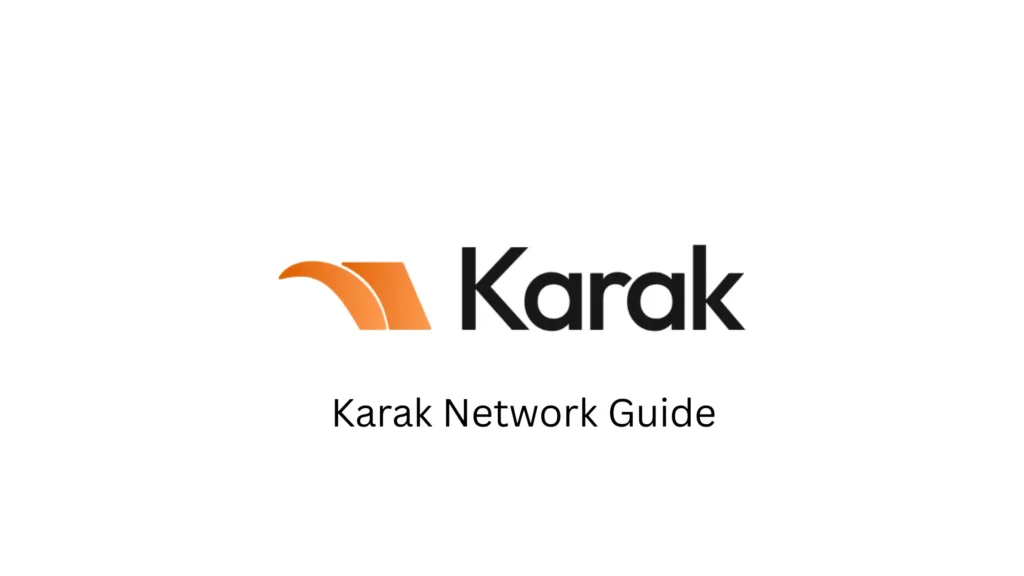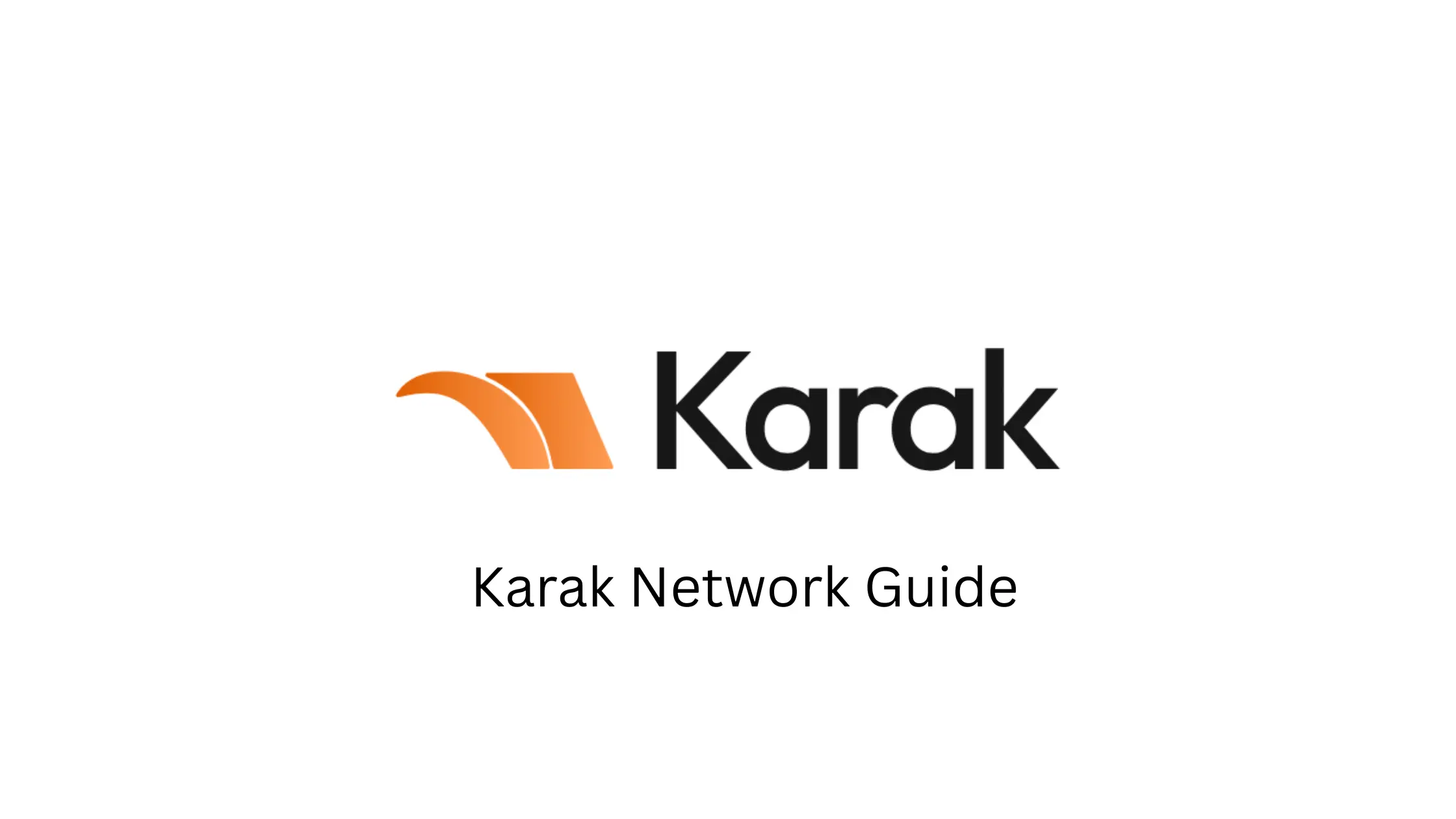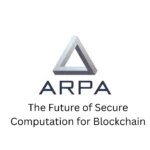The world of blockchain is on the verge of a paradigm shift with the arrival of karak network, a high-performance, multi-asset, restaking-focused Layer 1 protocol. Unlike traditional L1s that only focus on transactions or decentralized apps, Karak is building infrastructure to bring the entire global GDP on-chain. From restaking ETH and BTC to launching sovereign nation-state chains, Karak is aiming for the stars—and taking a bold, infrastructure-first approach.

Its native token, $KAR, will be central to this transformation, providing economic security, interoperability, and programmable settlement for an emerging generation of secure distributed services (DSS). With significant institutional backing and a clear roadmap, Karak Network is designed not just to scale crypto—but to redefine how the world leverages digital infrastructure for finance, governance, and data exchange.
What Is Karak Network?
Origins, Founders & Backers
The karak network project was founded by a powerful duo—Raouf Ben-Har and Drew Patel—who previously held influential roles at Coinbase and RiskHarbor. Their combined expertise in crypto infrastructure and smart-contract risk management provides a strong foundation for building what they describe as “programmable GDP infrastructure.”
From day one, Karak has attracted the attention of the crypto elite. In its $48 million Series A round, it was funded by giants such as Coinbase Ventures, Pantera Capital, Lightspeed, and even Mubadala (the sovereign wealth fund of Abu Dhabi). This level of institutional buy-in indicates high confidence in both the problem Karak solves and the solution it offers.
Karak is more than a blockchain—it’s a trust-minimized digital state machine designed to support everything from microfinance systems in developing nations to sovereign digital currencies.
Vision: Programmable GDP & Restaking
Karak’s mission revolves around the idea of enabling Programmable GDP—allowing entire economic systems, from taxation to public services, to operate on programmable, interoperable rails.
This means not just building another Ethereum competitor but crafting a platform where:
- Governments can issue and manage digital identities and land registries.
- Financial institutions can deploy credit markets and sovereign bonds.
- AI services can verify, license, and monetize datasets in real-time.
To enable this, Karak uses restaking as the core security mechanism. Unlike traditional staking, restaking allows multiple protocols and services to reuse the same staked collateral—ETH, BTC, stablecoins, and governance tokens like MKR—to secure a broader range of applications and services. This model dramatically increases capital efficiency and lowers the barrier for deploying sovereign-grade infrastructure.
Key Features of Karak Network
Multi‑Asset Restaking & Shared Security
One of Karak’s standout innovations is its multi-asset restaking framework. Most restaking protocols are limited to ETH or ETH-based derivatives, but Karak has cracked the architecture to accept and manage diverse digital assets securely. This includes:
- Liquid staking tokens (LSTs): wstETH, rswETH, swETH
- Stablecoins: USDC, USDT
- Major cryptocurrencies: WBTC
- Governance tokens: MKR and potentially others like AAVE, COMP
The shared security model pools restaked assets and allocates them across multiple applications and validators, dramatically improving resilience and scalability. Validators in the Karak ecosystem are incentivized to perform duties for multiple DSS while maintaining integrity, as malicious behavior is punishable by slashing—a loss of staked assets.
This design creates an ecosystem of economic guarantees, where multiple services benefit from a larger and more diverse pool of collateral.
Karak Network Stack (KNS)
The Karak Network Stack (KNS) is a toolkit for building secure, scalable sovereign blockchains. Think of it as an all-in-one development and deployment suite for digital states. KNS includes modules for:
- Secure state machines
- Cross-chain messaging
- Sovereign consensus mechanisms
- On-chain identity, tax, and compliance
The goal is to let builders—from fintech startups to national governments—spin up custom Layer 1 chains that are fully interoperable and restaking-secured, while retaining sovereignty over data and governance.
Distributed Secure Services (DSS)
DSS are the backbone of Karak’s infrastructure. These are highly secure, modular services that run atop restaked assets and perform critical functions such as:
- Verifying AI model integrity
- Managing KYC/AML identity registries
- Settling high-frequency trading across national exchanges
- Maintaining public record systems like land titles or birth certificates
In essence, DSS provide the trust and compute layer for programmable public infrastructure. By decentralizing the execution of these tasks, Karak enables a future where core governance and economic systems run transparently and efficiently on-chain.
Karak Token ($KAR): Tokenomics & Utility
Token Launch & Distribution
The $KAR token is Karak’s native digital asset, and it plays a central role in network functionality. Though the token is yet to be publicly traded, it has already generated buzz due to its strong utility and airdrop campaign.
Initial distribution is focused on:
- Early contributors and backers
- Restakers who earned XP
- Ecosystem developers and integrators
The total supply of $KAR is expected to be capped, with a percentage allocated for:
- Staking incentives
- Validator rewards
- Ecosystem development
- Governance participation
Over time, $KAR will become the engine that fuels everything from restaking and DSS security to settlement fees and inter-chain liquidity pools.
Services Powered by $KAR
$KAR is not just a governance token—it is a multi-functional asset. It’s designed to:
- Serve as a collateral token in restaking protocols
- Pay for gas across KNS chains
- Settle payments between sovereign blockchains
- Anchor stable economic zones alongside assets like BTC
This makes $KAR integral to the financial plumbing of Karak’s decentralized nation-state architecture. As adoption grows, demand for $KAR will grow in parallel, especially as more builders rely on it for securing and transacting across their sovereign domains.
Cross‑Chain Interoperability
The ability to bridge and transact seamlessly across custom L1s is critical to Karak’s vision. With $KAR, cross-chain functionality is native—not retrofitted. Sovereign chains built on KNS will be able to:
- Share security via a unified validator set
- Exchange assets using Karak’s atomic swap modules
- Execute cross-chain governance proposals
This architecture makes $KAR a universal lubricant for an economy of digital nations—offering a level of composability not yet seen in Layer 1 ecosystems.
Roadmap & Milestones
V2 Mainnet Launch & Features
In Q3 2025, Karak achieved a major milestone with the launch of its V2 Mainnet, bringing to life core components such as:
- Native slashing: Validators are financially penalized for misbehavior
- XP tracking: Users begin accruing experience points for staking and usage
- Support for multi-asset restaking: MKR, BTC, and stablecoins
This release marks the transition from a prototype to a fully-operational economic security layer—one capable of supporting both complex smart contracts and sovereign-scale services.
2025 Roadmap Phases
Karak’s 2025 roadmap includes three strategic phases:
- Phase I – Infrastructure Scaling: Expand validator set, improve UX for restaking, integrate more LSTs and stablecoins.
- Phase II – Ecosystem & DSS Expansion: Launch developer SDKs, enable third-party DSS modules, and begin pilot programs with governments.
- Phase III – Global Rollout: Launch sovereign KNS chains with built-in regulatory compliance and cross-border interoperability.
Each phase is geared toward making Karak a backbone for trustless digital public infrastructure, whether it’s a land registry in Kenya or a central bank digital currency in the UAE.
How to Participate & Restake
Earning XP & Preparing for Airdrops
Karak incentivizes early adoption through an XP (experience points) campaign, a mechanism designed to reward proactive contributors and future airdrop recipients. This gamified participation system allows users to accumulate points through specific on-chain actions such as:
- Restaking assets (e.g., wstETH, swETH, WBTC, USDC, MKR)
- Interacting with Karak’s testnet and dApps
- Completing tasks such as referrals, bridging, or liquidity provisioning
- Joining governance, reporting bugs, or offering community support
Unlike one-time airdrops that reward only early speculation, the XP campaign emphasizes ongoing contribution and loyalty. This XP accrual mechanism is directly tied to eligibility for future distributions of the $KAR token, making it crucial for users who want exposure to the project early without needing to purchase tokens from an exchange.
The XP leaderboard ranks participants by their accumulated actions, encouraging healthy competition. Many speculate that top XP earners may receive governance roles or priority access to sovereign chain deployments.
Supported Assets & Protocols
What truly sets Karak apart is its flexible and inclusive staking model. Traditional platforms may only allow native assets (like ETH), but Karak supports a wide array of crypto assets from day one. Users can restake:
- Liquid Staking Derivatives (LSTs) like wstETH, swETH, rswETH
- Stablecoins such as USDC and USDT
- Wrapped Bitcoin (WBTC) to bridge Bitcoin’s economic power into Ethereum-based staking
- Governance tokens, like MKR, which is unprecedented and signals deep integration with DeFi protocols
This inclusive approach means a broader pool of DeFi users can contribute to Karak’s security model—while earning rewards and XP.
Moreover, the protocol has built in a modular integration system, allowing third-party staking providers and wallets to plug directly into its restaking interface. This opens the door for integrations with platforms like MetaMask, Coinbase Wallet, and Ledger in the near future.
Community, Ecosystem & Partners
Projects & Integrations
A thriving ecosystem is critical for the longevity of any Layer 1 network. Karak is already forming strong connections across the blockchain landscape. Some key ecosystem relationships include:
- MakerDAO: Integrating MKR into Karak’s native restaking protocol—the first such partnership of its kind
- Ether.Fi and Swell Network: LST providers whose tokens (rswETH, swETH) are already usable on Karak
- Subsea and Karak Builders Guild: Incubators supporting DSS applications and decentralized infrastructure
These integrations indicate that Karak is not simply a stand-alone project—it’s becoming a hub where DeFi, governance, and real-world infrastructure converge.
Karak also promotes innovation through grant programs and developer hackathons, empowering new builders to experiment with sovereign chain deployments or novel DSS applications (e.g., AI data registries, civil registration apps, and decentralized finance rails).
Developer Tools & SDKs
For Karak to achieve true scalability, developers need powerful and accessible tools. That’s why the team is focused on delivering a complete suite of SDKs and APIs designed for:
- DSS creation and deployment
- Cross-chain governance protocols
- Custom sovereign L1 configurations
- Compliant DeFi infrastructure
The SDK stack will allow projects to define their own consensus rules, validator requirements, slashing parameters, and tokenomics—all while plugging into Karak’s global security and liquidity layer.
By lowering the barrier to building compliant and scalable sovereign blockchains, Karak becomes not only a platform but a developer’s playground for programmable economies.
Risks & Considerations
Smart‑contract & Slashing Risk
No matter how advanced a protocol is, smart-contracts are never immune to bugs, hacks, or misbehavior by validators. In Karak’s restaking model, malicious behavior or protocol failures could trigger:
- Slashing: A portion of restaked assets could be lost as punishment for faulty validator behavior
- Depegging of LSTs: If the value of tokens like rswETH or wstETH depegs due to external issues, participants could face unintended losses
- DSS risk: Applications built on top of Karak may introduce bugs or exploits that compromise their security layers, even if the core protocol remains secure
Users should understand these risks before restaking or deploying sovereign applications. Active monitoring, insurance protocols, and proper risk assessment tools are crucial.
Regulatory & Market Risk
Karak’s vision of sovereign chains and digital infrastructure sits on the frontier of global finance and governance. As such, the network may face:
- Regulatory scrutiny—especially in regions with ambiguous crypto laws
- Geopolitical risks—if nation-states leverage Karak for monetary infrastructure, geopolitical tensions could indirectly impact network integrity
- Market volatility—token prices, validator incentives, and adoption rates will all fluctuate based on wider market conditions
However, Karak’s flexibility and institutional engagement provide a level of resilience that many competitors lack.
Comparison with EigenLayer
Product Differentiation
At first glance, Karak Network and EigenLayer may appear similar—both offer restaking and decentralized security. However, the fundamental architectures and visions differ significantly.
| Feature | Karak Network | EigenLayer |
|---|---|---|
| Asset Support | Multi-asset (ETH, BTC, stables, MKR) | ETH and ETH-based tokens only |
| Token Utility | Native $KAR powers DSS, chains, and settlement | No native token yet |
| Ecosystem | Sovereign chain deployment with KNS | Focused on Ethereum middleware |
| Use Case Focus | Sovereign digital states, AI, public services | Oracle and middleware security |
| Validator Flexibility | Native slashing, multi-chain support | Ethereum-centric staking pools |
Karak takes a global infrastructure-first approach, while EigenLayer aims to secure Ethereum-based services. As such, Karak may be more appealing to developers and institutions aiming to build sovereign-scale applications, not just DeFi middleware.
Future Outlook & Use Cases
Sovereign Chains & Nation‑State Infrastructure
Imagine a future where:
- Nations issue and manage central bank digital currencies (CBDCs) on sovereign blockchains
- Governments maintain transparent land records, accessible to any citizen
- Public health, education, and voting systems are verified and settled on-chain
- AI companies tokenize and license models using decentralized proofs and payment rails
This is the world Karak is trying to build.
With KNS and DSS, any entity—public or private—can deploy a purpose-built digital economy that connects to a global security and liquidity fabric. The possibilities are virtually limitless:
- Latin American governments issuing programmable stablecoins
- African cooperatives managing microloans via local sovereign chains
- AI labs verifying large language models (LLMs) and enforcing digital rights
Karak is not just building a blockchain—it’s laying the foundation for programmable civilization infrastructure.
Frequently Asked Questions
1. What is karak network?
Karak Network is a next-generation Layer 1 blockchain that enables programmable GDP through restaking. It supports multi-asset collateral, sovereign chain deployments, and distributed secure services, aimed at revolutionizing how digital infrastructure is built and governed.
2. What is $KAR used for?
$KAR is the native token of Karak. It is used to pay for transaction fees, secure validator networks, support DSS operations, anchor sovereign chains, and facilitate cross-chain governance and settlement across the Karak Network Stack.
3. How do I earn Karak XP?
XP is earned through participation in the network. Actions include restaking assets like wstETH or MKR, referring users, engaging in governance, completing quests, testing dApps, and providing liquidity. XP determines eligibility for airdrops and other future benefits.
4. When will $KAR launch?
$KAR is expected to officially launch in mid-to-late 2025, following the release of key infrastructure features on the V2 mainnet. Users can prepare by restaking assets and accumulating XP to receive a share of the initial token distribution.
5. Is Karak safer than EigenLayer?
Karak introduces native slashing and multi-asset restaking, giving users more flexibility and transparency. While both networks carry risks, Karak’s modularity and sovereign chain approach allow for greater adaptability and governance control, but also introduce new risk factors to manage.
6. Can I stake stablecoins or governance tokens?
Yes, Karak supports restaking of stablecoins like USDC and USDT, as well as governance tokens like MKR. This broader asset compatibility increases network participation and security, making Karak one of the most accessible restaking protocols in existence.
Conclusion
The karak network is redefining what it means to build a blockchain. With its bold focus on sovereign-grade infrastructure, multi-asset restaking, and composable digital economies, Karak is well-positioned to lead the next evolution in decentralized technology.
Rather than building a niche ecosystem, Karak is constructing a global economic layer—capable of powering governments, institutions, and AI systems alike. For developers, validators, and early adopters, now is the time to get involved, earn XP, and help shape the infrastructure of tomorrow.




